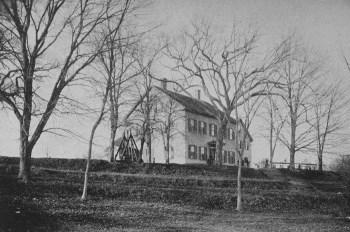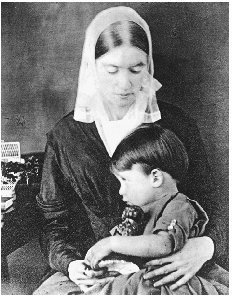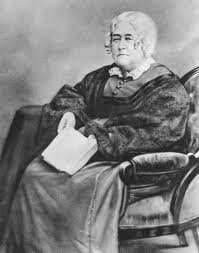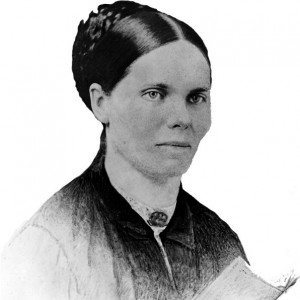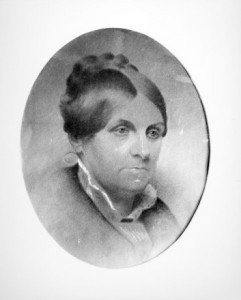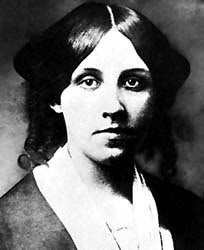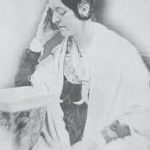A Massachusetts Commune
Image: Farmhouse at Brook Farm
Brook Farm, the most famous utopian community in America, was founded by Unitarian minister and author George Ripley and his wife Sophia in rural West Roxbury, Massachusetts in 1841. The Ripleys were interested in a more balanced society where equality was the norm and class distinction and wage discrepancy were not.
The Philosophy
In October 1840, George Ripley announced to the Transcendental Club that he was planning to form a Utopian community. Brook Farm, as it would be called, was based on the ideals of Transcendentalism. Poet Ralph Waldo Emerson was the center of the transcendental movement, setting out most of its ideas and values in a little book entitled Nature (1836) which represented at least ten years of intense study in philosophy, religion and literature.
The Ripleys subscribed to the transcendental philosophy espoused by poets and thinkers like Emerson and Henry David Thoreau, and they based their community on these ideals. The basic idea was that by pooling their labor efforts, a society could eliminate the drudgery of work and have time engage in intellectual pursuits and leisure activities.
A loose collection of ideas about literature, philosophy, religion, social reform, and the general state of American culture, Transcendentalism had different meanings for each person involved in the movement. The Transcendentalism Movement was a New England philosophy that led to well intentioned but perhaps misguided attempts to get back to nature, like Henry David Thoreau building his cabin by Walden Pond.
The Work
For free tuition in the community school and one year’s worth of room and board, the residents were asked to complete 300 days of labor by either farming, working in the manufacturing shops, performing domestic chores or grounds maintenance, or planning the community’s recreation projects. The founders believed that by pooling labor they could sustain the community and still have time for literary and scientific pursuits.
The idea was simple, everyone balanced out labor with leisure, so that everyone contributed to the commune. People could choose whatever labor they liked best, and all were given equal pay – including women. One of the things that made drudgery palatable was equal compensation. A child milking a cow was paid the same hourly rate as a former Harvard professor of Classics teaching in the school.
The Farm
George and Sophia Ripley formed a joint stock company in 1841 along with 10 other initial investors. They sold shares of the company at $500 apiece, with a promise of five percent of the profits to each investor. Shareholders were also allowed a single vote in decision-making and several held director positions. They received many applications, especially from people who had little money or those in poor health, but full-fledged membership was granted only to those who could afford the $500 share.
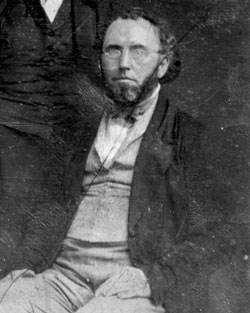
The Ripleys chose to begin their experiment at a dairy farm in West Roxbury, Massachusetts. They raised money, and the site was purchased on October 11, 1841 for $10,500, though participants had begun moving in as early as April. The 170-acre farm about eight miles from Boston was described in a pamphlet as a “place of great natural beauty.”
Image: George Ripley
The Farm’s primary appeal was to young Bostonians who were uncomfortable with the materialism of American life, and the community was a refuge for dozens of transcendentalists. There was a large farmhouse, soon to be christened the Hive because it would be the center of early Brook Farm life.
The Women of Brook Farm
In the beginning, Brook Farm worked around a policy of personal freedom and equality. Members were allowed to choose what kind of work they wanted to do, and special time was set aside for leisure and intellectual study. Women enjoyed much greater equality than was common at that time. Not only were they paid the same as the men, but they were considered autonomous from their husbands and were allowed to be shareholders in the community at large.
At Brook Farm, women had the opportunity to expand beyond their typical sphere of tasks and their labor was highly valued. They did have tasks that were typical of other women at the time such as simple food preparation and housekeeping. However, during the harvest time women were allowed to work in the fields, and men even helped out with laundry during cold weather.
Because of the community’s focus on individual freedom, women were autonomous from their husbands and were also allowed to become stockholders. Women also played an important role in providing sources of income to the community. Many devoted time to making, as Brook Farmer Marianne Dwight described, “elegant and tasteful caps, capes, collars, undersleeves, etc.,” for sale at shops in Boston.
Others painted screens and lamp shades for sale. Women were allowed to go to school and, because of the well-known education of women at Brook Farm, many female writers and performers visited the farm.
Brook Farm was centered on the ideals of radical social reform and self-reliance. The Transcendentalists’ reverence for Nature, and a deep belief in a divine spark in every person, led women like Elizabeth Peabody, Eliza Follen and Louisa May Alcott to take on the social ills of the nineteenth century including female education, women’s rights and abolition.
Some women became discontented with Brook Farm as soon as the novelty wore off. Annie Salisbury, an aspiring writer who had come to free herself of materialism and seek spiritual enrichment, wrote in her diary in 1841:
I think this present life gives me an antipathy to pen and ink. In the midst of toil, or after a hard days work, my soul obstinately refuses to be burned out on paper. It is my opinion that a [wo]man’s soul may be buried and perish under a dung heap, just as well as under a pile of money.
Sophia Ripley
Sophia Willard Dana Ripley (1803–1861) was a 19th-century feminist. When she was a girl, her father traveled abroad often and left his daughters to fend for themselves. In 1823, the Dana sisters decided to earn their own living by teaching. They established a girl’s school in Cambridge, Massachusetts, and Sophia served as the principal teacher.
Sophia first met George Ripley during his final year as a student at the Harvard Divinity School in 1825. In 1826, they became engaged, though Ripley did not tell his parents right away. He asked his sister Marianne to inform them, assuring them that their relationship was not based on “any romantic or sudden passion.” They were married on August 22, 1827.
Sophia Ripley was also among the few regular women guests of the male-dominated Transcendental Club in the 1830s. She wrote a revealing essay entitled Woman, which was published in The Dial, the club newspaper, just before she moved to Brook Farm:
Woman is educated with the tacit understanding, that she is only half a being, and an appendage. First, she is so to her parents, whose opinions, perhaps prejudices, are engrafted into her before she knows what an opinion is. Thus provided she enters life, and society seizes her; her faculties of observations are sharpened, often become fearfully acute, though in some sort discriminating, and are ever after so occupied with observing that she never penetrates.
In the common course of events she is selected as the life-companion of some one of the other sex; because selected, she fixes her affections upon him, and hardly ventures to exercise upon him even her powers of observation. Then he creates for her a home, which should be constructed by their mutual taste and efforts. She finds him not what she expected; she is disappointed and becomes captious, complaining of woman’s lot, or discouraged and crushed by it.
She thinks him perfect, adopts his prejudices, adds them to her early stock, and ever defends them with his arguments; where she differs from him in taste and habits, she believes herself in the wrong and him in the right, and spends life in conforming to him, instead of moulding herself to her own ideal. Thus she loses her individuality, and never gains his respect.
Along with her sister-in-law Marianne Ripley, Sophia oversaw Brook Farm’s schools, and taught history and foreign languages. There was an infant school, a primary school and a college preparatory course covering six years. A school of the highest educational standards, it was so well respected that Harvard recommended it to students preparing for its college.
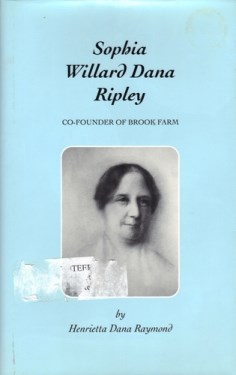
The school was Brook Farm’s only economic success, and one of the finest boarding schools in New England, with a teaching staff composed entirely of graduates of Harvard and Radcliffe. Its curriculum was a blend of the best classical education of the time and new methods.
Image: Rare photo of Sophia Ripley
Students included Margaret Fuller’s younger brother, Ralph Waldo Emerson’s nephew, Orestes Brownson’s son, Theodore Parker’s ward and Francis Shaw’s son, Robert Gould Shaw, who later led the all-African American 54th Massachusetts Infantry in the Civil War.
Sophia Ripley was greatly influenced by Orestes Brownson, an intellectual and activist, preacher, labor organizer, writer and noted Catholic convert. She converted to Catholicism in 1846 and became a dedicated member of the church, leading her to eventually become a nun; her husband never converted. By the 1850s their relationship had become strained. She died in 1861.
Nathaniel Hawthorne
One of the initial founders of Brook Farm was author Nathaniel Hawthorne. Hawthorne did not particularly agree with the ideals of the experiment, but was hoping that it would help him raise enough money to begin his life with his wife-to-be Sophia Peabody. She considered moving there as well and even visited in May 1841, though Hawthorne sent her away.
Ripley was aware of Hawthorne’s motivations, and tried to convince him to get involved more fully by appointing him as one of four trustees, specifically overseeing “Direction of Finance.” After requesting his initial investment be returned, Hawthorne officially resigned from Brook Farm on October 17, 1842.
Ripley could not afford to return the investment of the departed Hawthorne. He was having difficulty figuring out how anything was going to be paid for, even food. Ripley suddenly realized that:
…the purely democratic, Christian principles on which he had established the community wouldn’t provide even a single meal for seventy Brook Farmers living on a dairy farm in West Roxbury, Massachusetts.
Nathaniel Hawthorne filed a lawsuit against George Ripley in 1845, seeking to recover his $500 investment. Ripley conceded the truth of Hawthorne’s claim, but there was no money to pay him. It is unlikely that Hawthorne was ever repaid.
The Community
Brook Farm provided housing, fuel, wages, clothing and food to all members, their children and family dependents. They tried to self-sustain by farming, running the boarding school, and selling goods made by the residents, but they were never able to fully get out of debt. Months of hard work produced little income.
The school did well, but could not pay the expenses of the Farm, much less the cost of the aggressive building projects. They built another building, the Nest, followed by the Eyrie, the Cottage and the Pilgrim House. In order to do this, Brook Farm took on $6000 of new debt, bringing its total debt to almost $15,000 – a staggering amount for a community with little prospect of any reliable income.
Brook Farm’s experiment in putting community above the person was not acceptable to individualist intellectuals like Margaret Fuller. Nevertheless, Fuller made the first of many visits to Brook Farm in 1841. The Farmers even named their newly built cottage after her. After much soul searching, Fuller, Emerson and Thoreau (who visited many times) declined to join the community.
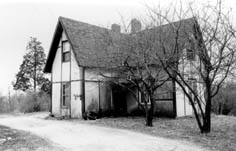
Image: Margaret Fuller Cottage at Brook Farm
By 1842 there were more than seventy people living at Brook Farm. Most of the new residents never paid their shares, and the association bore the cost of housing and boarding them. The visionaries and idealists who made up the community were not inclined to be strict with the members or to be thrifty with the budget. This attitude, more than anything else, was responsible for the failure of Brook Farm to thrive.
Confident that Brook Farm would recover, the members began to construct a massive communal house to accomodate the current membership of over 100 people, “centralizing all the public rooms: the parlors, reading room, reception rooms, general assembly hall, dining room capable of seating over three hundred people, kitchen and bakery.”
In late 1845 a Brook Farm boy, visiting his aunt and uncle in Boston, caught smallpox. Before his symptoms appeared he brought the infection home, exposing the whole community. Nearly one third of residents had to be quarantined. All work at the Farm stopped, except caring for the sick, further exacerbating their financial problems.
In 1846 the association decided to devote its remaining resources to completing the large community building. If they could complete that impressive structure, it might attract new investors and members. To celebrate resumption of construction the community threw one of its famous parties.
While they were dancing, the new structure caught fire and burned to the ground, later blamed on a faulty flue. Because it was not yet insured, it was a complete loss. After the fire there were about sixty-five people remaining in the community. A few months later there were only thirty, and virtually all of the students were gone. Brook Farm could not recover.
Late in 1846, several hundred volumes of the library which Ripley had brought with him to Brook Farm – one of the finest personal collections in the United States – were sold at auction in Boston to pay debts. Ripley is reported to have remarked to a friend at the time, “I can now understand how a man would feel if he could attend his own funeral.”
Bankruptcy proceedings were completed in 1847. During the Civil War the State of Massachusetts used the land as a training camp for Union soldiers. Today, the buildings of Brook Farm are gone but the land has been preserved as a National Historic Landscape under the auspices of the Massachusetts Department of Conservation and Recreation.
SOURCES
Brook Farm
Wikipedia: Brook Farm
Wikipedia: Sophia Ripley
The Women of Brook Farm
